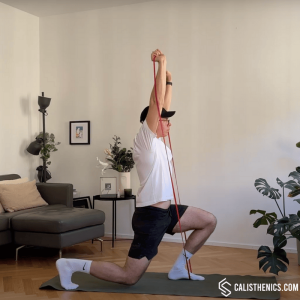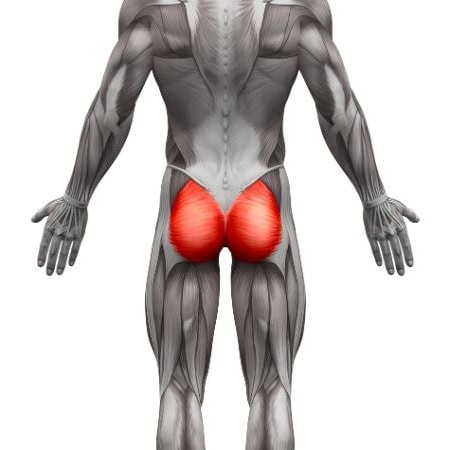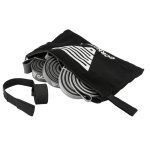Resistance Band Overhead Lunges
How to do Resistance Band Overhead Lunges?
Resistance band overhead lunges are a challenging lower-body and core exercise that also engages the shoulders and upper back. Holding a resistance band overhead while lunging requires stability, balance, and core engagement, making this a functional and full-body movement. The overhead position adds difficulty by activating the shoulders and core, providing a comprehensive workout that improves strength, posture, and coordination.
Steps to Perform a Proper Resistance Band Overhead Lunge:
1. Anchor the Resistance Band Under Your Front Foot:
• Place the middle of the resistance band under the sole of your front foot, making sure it is securely fixed.
• Hold the ends of the band in each hand and extend your arms straight overhead, creating tension in the band. Your hands should be slightly wider than shoulder-width apart.
2. Set Up in a Standing Position with Arms Overhead:
• Stand tall with your feet hip-width apart, core engaged, and shoulders stable.
• Keep your arms fully extended overhead, ensuring the band is taut and your shoulders are actively engaged.
3. Step Back into a Lunge:
• Inhale as you step back with one leg, lowering into a lunge position.
• Bend both knees to form 90-degree angles, keeping your front knee aligned over your ankle and your back knee just above the ground.
• Focus on keeping your torso upright and your arms fully extended overhead, maintaining tension in the band.
4. Drive Through the Front Heel to Return to Standing:
• Exhale as you push through the heel of your front foot to rise back to the starting position, bringing your back leg forward to meet the front.
• Keep your arms overhead and your core engaged throughout the movement.
5. Repeat on the Opposite Leg:
• Alternate legs for each repetition, or complete all repetitions on one leg before switching to the other side.
6. Complete Desired Repetitions:
• Perform the desired number of repetitions on each leg, focusing on form, stability, and control in both the lunge and overhead hold.
Benefits of Resistance Band Overhead Lunges
• Builds Lower Body and Core Strength: This exercise engages the legs, shoulders, and core, building strength in multiple muscle groups.
• Improves Shoulder Stability and Mobility: Holding the band overhead enhances shoulder stability, which can improve posture and prevent injuries.
• Enhances Core Stability and Balance: The overhead position requires core engagement, improving balance and control, especially during the lunge.
• Promotes Functional Strength: The combined overhead hold and lunge mimic real-life movements, enhancing functional strength and stability for everyday tasks.
• Portable and Convenient: With only a resistance band required, this exercise can be done at home or while traveling, providing a versatile alternative to weighted lunges.
• Joint-Friendly Resistance: The band’s smooth resistance is gentle on the joints, making this exercise accessible for people with various fitness levels.
• Increases Flexibility and Range of Motion: The movement improves hip, shoulder, and ankle flexibility, supporting overall mobility.
Common Mistakes to Avoid
• Incorrect Band Positioning: Make sure the band is securely anchored under the front foot and held overhead, preventing discomfort or slipping.
• Leaning Forward in the Lunge: Keep your torso upright, avoiding any forward lean that can strain the lower back and reduce leg engagement.
• Shrugging Shoulders: Keep your shoulders down and stable, avoiding any shrugging that could lead to neck strain.
• Using Momentum: Focus on controlled movements both when stepping back and returning to standing, avoiding the use of momentum.
• Allowing Knees to Collapse Inward: Ensure your front knee tracks in line with your toes to protect the knee joint and engage the correct muscles.
Tips for the proper execution of Resistance Band Overhead Lunges
Secure Band Position: Ensure the band is securely under your front foot and held overhead, preventing any slipping or movement.
Engage the Core: Keep your core tight to maintain balance and stability, preventing any forward or backward leaning.
Focus on Shoulder Stability: Keep your shoulders engaged and stable, preventing the band from pulling your arms forward.
Maintain Upright Posture: Keep your chest lifted, and avoid leaning forward, especially as you lower into the lunge.
Controlled Movement: Perform the lunge slowly and with control, focusing on both the descent and ascent to fully engage the muscles.
Muscles worked when doing Resistance Band Overhead Lunges
Primary Muscles:
•Quadriceps: Engaged during the lunge, responsible for extending the knee as you stand back up.
•Glutes: Activate to extend the hips, especially as you push through the front heel to return to standing.
•Shoulders (Deltoids): Engage to hold the band overhead, stabilizing the arms and shoulders.
Secondary Muscles:
•Core: The abdominals and obliques engage to stabilize the torso and prevent wobbling.
•Hamstrings: Support hip extension and help control the descent into the lunge.
•Upper Back and Traps: Assist in stabilizing the shoulders and holding the band overhead.
•Lower Back: The erector spinae muscles work to maintain spinal alignment and support an upright posture.
Primary Muscle(s):
Secondary Muscle(s):

Anterior delt

Abdominal
Adjust the difficulty of Resistance Band Overhead Lunges
How to make Resistance Band Overhead Lunges harder?
How to make Resistance Band Overhead Lunges easier?
How to make Resistance Band Overhead Lunges harder?
To make Resistance Band Overhead Lunges harder:
-
Use a Heavier Resistance Band: Increase the challenge by using a band with more resistance, requiring greater shoulder stability and core engagement.
-
Add a Hold at the Bottom of the Lunge: Pause for 2-3 seconds at the bottom of the lunge to increase time under tension, maximizing muscle engagement.
-
Slow Down the Eccentric Phase: Take extra time lowering into the lunge to focus on control and engage the muscles more deeply.
-
Increase Repetitions or Sets: Perform additional repetitions or sets to build endurance and further challenge your legs, shoulders, and core.
How to make Resistance Band Overhead Lunges easier?
To make Resistance Band Overhead Lunges easier:
-
Use a Lighter Resistance Band: Start with a band that provides less resistance, allowing for easier overhead stability and control.
-
Limit Range of Motion: Perform a partial lunge, lowering only halfway to reduce intensity while improving form and balance.
-
Practice the Overhead Hold Separately: Build strength and stability by practicing the overhead hold in a stationary position before adding the lunge.






